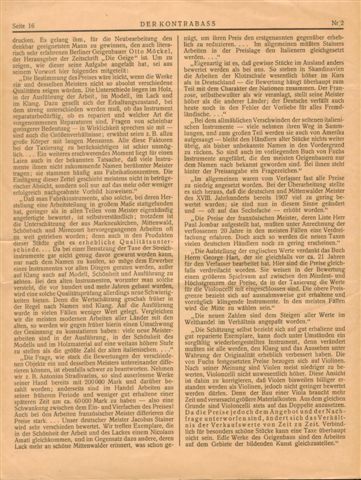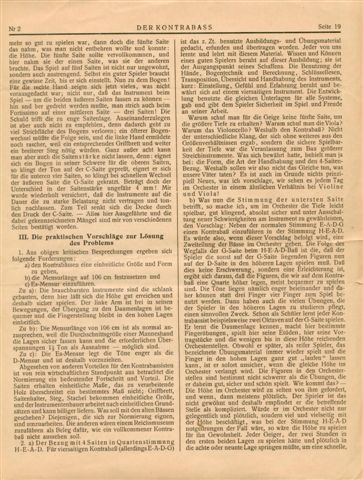The Corner Of Klaus Stoll |
||||
Der Kontrabass 1929-1931For my first participation, I would like to illustrate a historical issue concerning the publishing of the first magazine entirely dedicated to the double bass. It was 1929. The world was experiencing its first big economical crisis since the Industrial Age. In the meantime, Europe was passively assisting the uprising of a number of ideologies and totalitarian regimes, the social realism of the Union of Soviet Republics on the one hand and Hitler and Mussolini’s Nazi-fascism on the other. Moreover, Thomas Mann was awarded the Nobel Prize for literature, Leon Theremin patented the first electronic musical instrument ever - the Theremin -, Dimitri Shostakovich composed his Third Symphony in F Major Op. 20, while Paris was enjoying the first performance of Sergej Prokoviev's Third Symphony. In Germany, the Weimar Republic was experiencing its last days and there was the attempt to constitute a democratic government, with the consequent rise of the National-socialist party. Notwithstanding this difficult situation and the growing economic crisis, two famous double bass players and professors, M° Friedrich Warnecke, professor at the Hamburg Conservatoire, and M° Theodor Albin Findeisen, who studied with Franz Simandl in Vienna and played as first double bass at the Gewandhausorchester in Leipzig and who also worked as double bass professor at the local conservatoire, wrote articles, studies and training exercises for the double bass and the musical study in general, decided to establish an unusual initiative for those times: a magazine for the double bass world, Der Kontrabass. We should bear in mind that, despite it having been played for over a century, the double bass was still considered as a "new" instrument, not from the point of view of repertoire, for which there was a good number of sheet music available and even "virtuoso" pieces, which, although still rare and with some exceptions, aimed at defining special "situations" and atmospheres. From a teaching method point of view, though, it was different. Of course, there was already a good number of teaching methods, including works by Bottesini and Simandl. Nevertheless, it is only during these years that, in the national territory, some real and proper modern schools aimed at defining the professional technique, finally considering the double bass to be at the same level as other string instruments: Isaia Billè and Italo Caimmi in Italy, Josef Hrabe, Ludwig Manoly, Adolf Mišek and Theodore Albin Findeisen in the Prussian area, Edouard Nanny in France and Herman Reinshagen in the United States. Since the beginning the aim of this magazine was to show and put in order the different emerging schools, by outlining some technical and physical aspects of the instrument that have always been at the core of the study, sometimes also with disadvantage of instrumental practice. It was an absolute and prophetical project of what today has become a must of the multimedia communication. On the pages of Der Kontrabass there was a real discussion forum, where the readers' comments were published. Unfortunately its difficult international publication, also due to the version in German only and national economic problems with the relative cutting of funds for cultural activities, the rise of German nationalism fostered by Hitler's supporters, who rejected any move that might act as a bridge between German culture and the rest of the world, as well as the little interest of private investors in a financial cooperation to support this magazine, led to the end of this pioneering project in 1931, just after the fourth issue was published. I wanted to gift M° Boccini, Xbass’ artistic director, with Issue No. 2 of this magazine, with by best personal wishes and support for this great new project, in the hope that it will last much, much longer !!! |
||||
For a better resolution, click over the picture |
||||
Klaus Stoll |
||||
Send a comment!!! |
||||




 "I am Klaus Stoll, actually the oldest pf the Berlin Philarmonic, but, still posessed by music (goog music!!!) and always one of the youngest at the moment of enjoying my heavy bass's sound. Of course , the upper frame of my desk I'll never accept, it's my horizon. All the great composer's messages, I was privileged to receive during 7000 rehearsals and 5000 Philarmonic concerts, and together with a handful of respectful directors and musicians-even lots of music-lovers - have made me a rich man...
"I am Klaus Stoll, actually the oldest pf the Berlin Philarmonic, but, still posessed by music (goog music!!!) and always one of the youngest at the moment of enjoying my heavy bass's sound. Of course , the upper frame of my desk I'll never accept, it's my horizon. All the great composer's messages, I was privileged to receive during 7000 rehearsals and 5000 Philarmonic concerts, and together with a handful of respectful directors and musicians-even lots of music-lovers - have made me a rich man...







